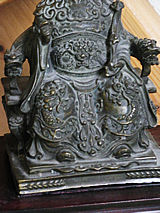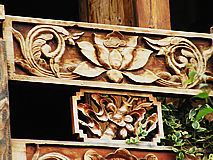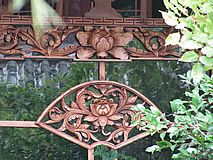CultureRenewalInitiative
HEALING THE PLANET
To begin with yourself
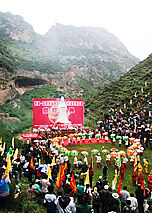
Ceremony in honour of Xiwangmu
(Kunlun Mountains)
Mother China 2
(Chinese Mother Religion)
| Xiwangmu The first reason why Ximangmu is so incredibly important is that She embodies the Primordial Mother of China. She can be considered the "materialisation" of the Cosmic Egg. Secondly, equally important, is the fact that there can be no doubt about the link She has with Kybele, the ancient Mother of Anatolia. If this indeed is true, then my thesis about the origination of the Mother and Her successors towards the East (Xiwangmu, Kali) and the West (Kybele, Isis, the Black Madonna) cannot be denied anymore. They are all manifestations of ONE underlying Mother "archetype". Everything is born out of one Cosmic Mother! |
THE MOTHERS OF CHINA |
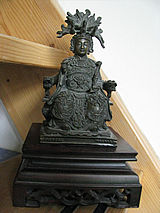 I was extremely lucky to be able to buy this Xiwangmu statue |
| Son/Lovers of the Mother (e.g. in the West Osiris; in the East the Yellow Emperor) were still part of the Whole. Therefore, their concerns included the whole world. They were Renewers of the entire culture. The "Divine Heroes" of later times (Buddha, Jesus) had a much more limited scope: the liberation/ salvation of individual souls, only. | In the West the males "in order to grow" rejected the Divine Feminine. Gilgamesh rejected Ishtar on his quest towards immortality; the God Marduk killed Mother Tiamat in order to rule. In Taoism Xiwangmu, however, kept Her Supreme Position while men continued to consult Her in their various stages of development throughout the ages, from archaic times where She ruled over "death and rebirth", then as Guardian of immortality, then as Ruler and Teacher. In the East the lineage of the Mother and Her Son/Lovers was unbroken for many centuries. Spectacular are recent efforts of Chinese authors to connect Xiwangmu and the Yellow Emperor as Her Son/Lover. Really an eye-opener to me! |
Two of the most beautiful, deep, scholarly books about Xiwangmu and the Tang I have read: Suzanne E.Cahill " |
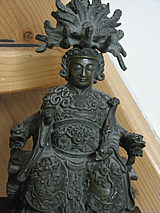 Here She is depicted with Dragons + a headdress with Her three blue/ green birds |
What connects Xiwangmu with Kybele? Well, first of all they are both Mothers of "birth and death", proof of the fact that they still unite polarities, which is the characteristic of Primordial MotherGoddesses. Secondly, they are both "Mothers of the Gods", birthgivers of the Son (Light, the Divine, the Dragon), e.g. the Jade Emperor ("Green Man!") and other immortals. Their dependency on the Mother is emphasized by "Peach (symbol of the Womb) Parties", which means that they have to regularly return to the Womb in order to become renewed. Thirdly, they are both called "Mother of the Mountains", which links to very ancient sources. Fourthly, they are both "Ladies of the animals" with the lion e.g.the tiger as their favorites |
In total there are nine Dragons, all Sons of the Mother, making this statue one in the line of the "Lady and Her Beasts", another link with the Near East (See also later). The Dragon in the centre could also be a Kirtimukha, a mask proving Her ancient origin |
| NüWa Nüwa (Goddess) and Fuxi (God) as two polarities. Although these images are rather old - older than images of Xiwangmu - the true sequence is that Xiwangmu is the Origin, while the polarities - Yin and Yang - are born out of the former. Nüwa is furthermore known as the Goddess Who first destroyed the earth, while subsequently creating humans out of clay. She might therefore be called "Mother of the Earth" |
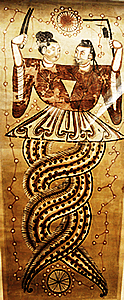 The Yin/Yang Spiral |
THE KINGDOM OF WOMEN Daughters of the Mother
|
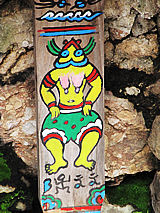 Naxi Goddess at the well in Lijiang |
At the times of early Tibetan-Buddhist kings (around 8th century CE) the regime started to persecute the ancient Bön religion. Many centuries earlier (Han Dynasty) patriarchal Han people from the North (like the Aryans in India) pushed South. On their way they expelled the existing peoples, many of them were matrilinear. These exodusses - one from the West eastwards and one from the North southwards - met in the mountains of southern China, in particular in Sechuan and Yunnan. Those in very remote areas managed to maintain their Mother-centered lives. As a whole the minorities in the South still have many links to matriarchy | 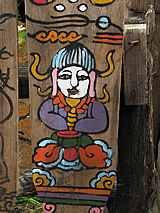 Naxi Goddess |
| Naxi & Mosuo Perhaps the most wellknown peoples are the Naxi and the Mosuo. The former still have traces of Goddess worship, while the latter still maintain a matrilinear society. MeiMei (my wife) and I were very priviledged to be able to visit both these peoples See also: "Other Chinese Minorities" |
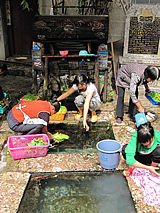 The central well in Lijiang with Goddess image (here difficult to see) |
|
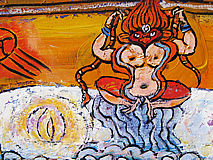 Vulva (Cosmic Womb) with Goddess |
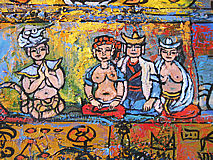 Goddess Worship |
|
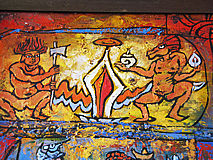 Womb Worship |
How the Mosuo still (secretly) hate the dominance by Han people: "Just as there are no white crows in the white sky, there isn't any good Han person" (old Mosuo mother). Many minorities detest the single-mindedness of the Han, as one Mosuo woman said: "In a Chinese city I cannot be publicly happy and sing. If I do then they consider me mad". She feels the Han oppress themselves and therefore others | |
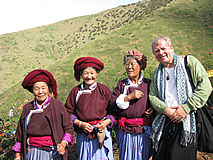 Mosuo Grandmothers Link to our special Mosuo Report (1 to 3) |
In Tongqiao, a town near Chongqing a "Kingdom of Women" is being built. Meant as a tourist attraction it wants to highlight feminist lifestyle and matriarchy. Men will have the "opportunity" to submit to female authority..... | 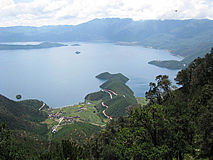 Lugu Lake (Mosuo Territory) |
| WOMEN SHAMANS | ||
| Women shamanism has strong roots in Asia. Originally, it is directly derived from the MotherGoddess, participating in Her all-inclusive Web of Life. Shamans restore Wholeness. In later times the Mother had to give way to the Gods. A distance was created between humans and the Divine. It changed the function of the shamans. She and her male collegues became mediators between the two worlds. |  Mandshurian Woman Shaman |
Women have always been central in the community. They are the guardians of continuity. As shamans they provide wellbeing, relationships, fertility, childbirth, healing, divination, ancestor worship, (white) magic and prophecy. The rationalist masculine mind has always looked with suspicion (and fear) to these practices. It is the reason that up to this day "shamanism" is forbidden by the central Chinese Government |
TANG DYNASTY |
||
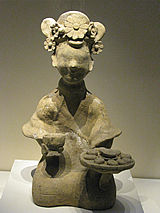 This could be a lady offering cakes and wine to the Goddess. If so, then this is spectacular, for this was common practice in the Near East as well (Bible: Jeremia 44) |
The feudal Chinese society was brutal towards women. The
latter had no rights, no any freedom whatsoever. They were treated like slaves. From 618
to 765 CE however, there was a brief relief from oppression. It can be compared with the
European period of Courtly Love. During the Tang, women enjoyed not only a great deal
of freedom, but also a high social status. The former could have property, divorce, ethnic
intermarriage, education with the chance to learn history, politics and military
skills....Women could drink wine and sing loudly in taverns and compete with men on the
polo field. Some attained the highest position, like Empress Zhangsun |
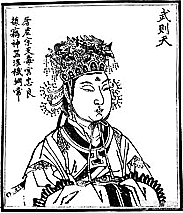 Tang Empress Wu Zetian |
WOMB SYMBOLISM |
||
| In later centuries: although the Mother in Her original Glory had been largely pushed into a small corner, some of Her symbols are still everywhere. Two of them are the "Vessel of Abundance" and the Lotus. The former - corresponding with the Grail! - is universal and can be found in almost all cultures. (LINK: Istanbul Cemetary). The Lotus, symbol of the Cosmic Womb - is more specific for Asia. PS. The third symbol is the Shell/Womb. You may find it in particular in Western cultures. LINK: The Universal Shell | 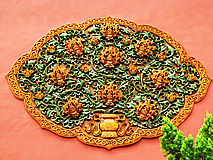 Vessel with gorgeous vegetation - branches, leaves and flowers - a little resembling a Tree of Life |
|
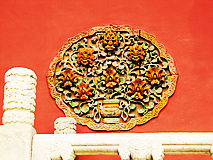 |
THE "VESSEL (CAULDRON) OF ABUNDANCE" (GRAIL!)
IN THE FORBIDDEN CITY |
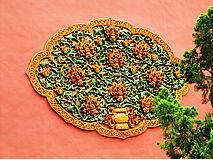 |
|
Sacred Vessels are universal, because.....the Mother is universal. In fact, it is still in the collective unconsciousness of people worldwide. Logically, for we all have the "memory" of the mother (Mother) within us | |
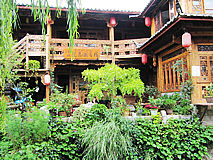 |
LOTUS/WOMB symbols I have seen everywhere in Asia. These are particularly beautiful, all carved in wood on a beautiful house in Lijiang (Yunnan) |
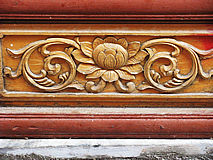 |
|
||
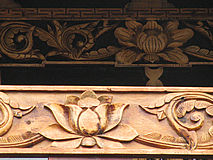 |
Rather than serving a Buddha sitting on Her, the Lotus appears very often in Her own right. In case of the former: the Buddha's are not sitting ON the Lotus, they are born out of Her. Hence Mother-Loving people worship the Lotus above all, the "Son" ("Daughter") comes second |
 |
|
||
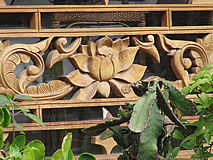 |
To be continued |

In order to have a full overview of the
work,
we recommend you to first going back to the beginning of
Han Marie Stiekema's website.
Please, click HOME and proceed from there.
Both the Dragon as well as the "feathered Blue/Green Bird" are "Son/Lovers" of Mother Xiwangmu. In Mexico the "Feathered Serpent" Quetzalcoatl is the Son/Lover of the Great Mother of Teotihuacan (Aztek). This is certainly NOT an "accidental" parallel!
THE MOTHERS OF CHINA
Apart from the major Mothers mentioned already, China is litterally covered
with (Mother)Goddesses
The Mysterious Female (Tao Te King) * The Female Shen Deity (Wife of Pan-ku) * The Western
Mother * The Eastern Mother * Ti-Mu (Earth Mother) * Hsi-Ho (Mother of the Suns) *
T'ien Mu (Mother of Heaven) * Heng-O (Sister of the Emperor) * The Daughter of the Moon
Goddess (Monkey Tale) * Queen Mother Wang (Niang-Niang) * Nu Wo (Empress) * The
Mother Goddess (Jasper Pool) * Kuan-Yin (Goddess of Mercy) * Pa (Goddess of Drought) * Liu
Tsu (Empress) * Chin Nu (Wife of Celestial Herdsman) * The Female Tortoise of the North
(Tortoise Goddess) * The Huang (The Female Phoenix) * Ho Hsien-Ku (One of the eight
Immortals) * Sheng Mu (The Holy Mother) * The Lady of Good Sight * Sung Tzu Niang Niang
(Goddess of Fecundity) * Nu-Chiao (The Mother Stone) * T'ien Hou (Empress of Heaven) *
Hsi.Ho (Water Mother) * Shiu-Mu Niang Niang (Water Mother) * The Dragon Mother * The Jade
Princess (Sister of Jade Emperor) * The T'ang Empress * Jade Bud (Sister of T'ang Emperor)
* Blue Lotus (Underworld) * Lady Hsiang (Pottery Seller) * Wen-Ch'iao (In Monkey story) *
Perch Mother (Monkey) * The Pearl Princess (Monkey) * Tien Mu (Mother Lightning) * The
Dark Maid * The Yellow Empress (Grandmother of the Chinese Race) * Lady Horse-Head * The
Heavenly Ancestress (Mother of the first Emperor of the Tsing Dynasty) * Yu Chi (Queen) *
Yang Kuei-Fei * The Princess of Ch'in * The Seven Sisters of Industry (Pleiades) * How
Kung (Constellation Ursa Minor) * Nok (Constellation Aquarius) * Niu She (Constellation
Draco) * Yu Neu (Constellation Leo) * She Sang Neu (Virgo) * Tow Mu (Ursa Major) *
Mobo (Mother of Mencius) * Wen Ch'en (Tara) * The Triple Pussa (Triple Goddess) * Yang
Chen (Goddess of Teaching) * Sun-Goddess of Formosa (Ami people) * The Ami Goddess *
Ya-Hsek-Khi (Earth Goddess) * The Earth Goddess of Tarrtary) * The Female Idols of Xanadu
(Northern China) * White Wave (Fairy) * The Snake Princess (Phoenix Mountain) * Ma-Ku
(Fairy) * The Fuchow Princess (Ancestress of Miao and Yao tribes) * Meng Chiang Nu
(Pumpkin Girl) * Mo Yeh * The Bear Woman (Ancestress of Wang Clan) * The Hunan Maiden *
The Yellow Cow (Mother of Tao) * The Seventh Wife (Queen) * Chiu T'ien Hsuan-Nu (Dark
Maiden from Ninth Heaven) * Sea Girl (Southern Mountains) * The Dragon Princess (Wife of
Dragon King) * The Third Princess * The Maiden of Hsiang-Chou (Wife of Wei Ku) * The
Enchantress of P'u Chiang * Pai Mu-Tan (Courtesan) * Third Lady (Witch) * Maiden of Witch
Mountain * Wu (Queen of Heaven, Empress) * Aunt Piety (Magician) * Eterna (Sorceress) *
K'un (The Yin Principle) * Sun (The First Daughter) * Li (The Middle Daughter) * Tui (The
Youngest Daughter) * Mother of Ten Thousand Things (The Void) * The Earth Cow * Goddess of
Fertility and Birth * Goddess of Latrines * The Tenth Aunt (Village Deity) * P'an
Chin-Lien (Goddess of Prostitutes) * The Jade Girl * The Household Goddess
Lawrence Durdin-Robertson "The Goddesses of India, Tibet, China and Japan" (Cesara Publications)
1997-2012
© Copyright Han Marie Stiekema. All rights reserved.
Everyone may use this website as a source of inspiration. However, since it
is freely given, no-one can claim, copy or derive any text, rights,
position or status from this website.
Last revising: 07/19/13
